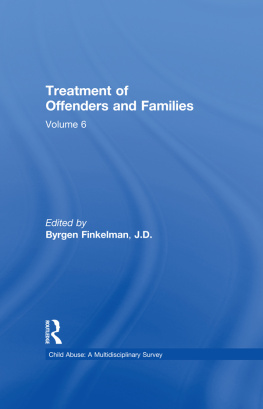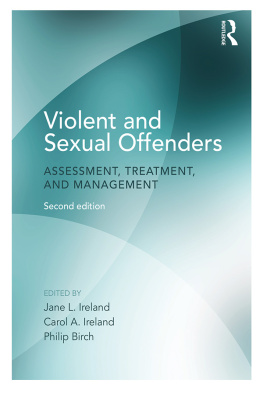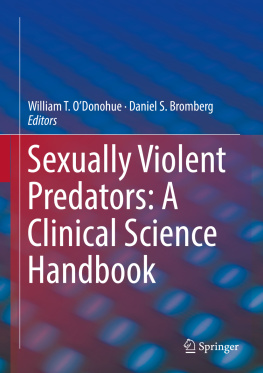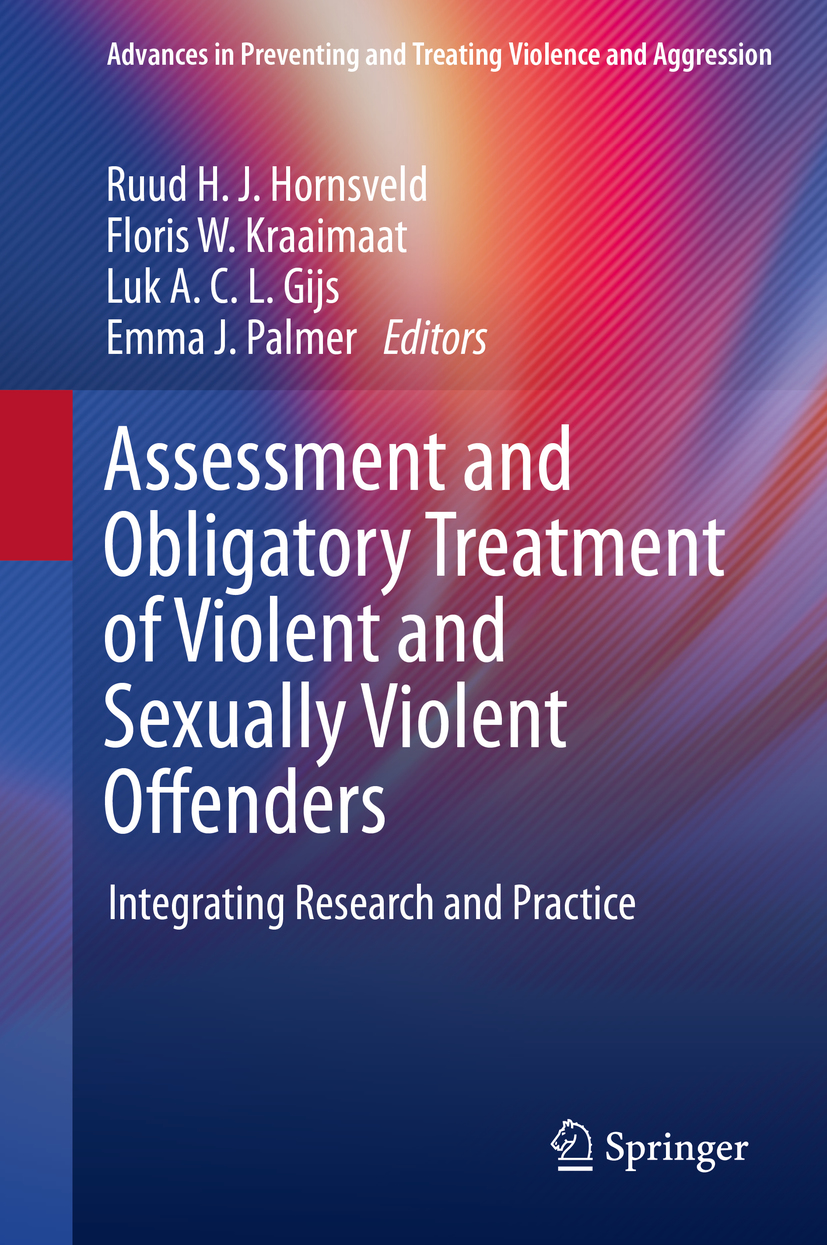Advances in Preventing and Treating Violence and Aggression
Series Editor
Peter Sturmey
City University of New York, Queens College City University of New York, Flushing, NY, USA
The series publishes books focused and developed across three domains. The first is understanding and explaining violence and aggression. Books in this domain address such subject matter as genetics, physiology, neurobiology, cultural evolution, biobehavioral, learning, cognitive, psychoanalytic, sociological and other explanations of violence. The second domain focuses on prevention and treatment for individuals and couples. Examples of books in this domain include cognitive behavioral, behavioral, counseling, psychopharmacological, psychosocial, couples, and family therapy approaches. They also explore extant treatment packages for individually focused treatments (e.g., mindfulness, cognitive analytic therapies). Within this domain, books focus on meeting the information needs of clinicians and professionals who work in youth facilities, emergency rooms, special education, criminal justice, and therapy settings. Finally, books in the third domain address prevention and treatment for groups and society, including topical focus on early intervention programs, school violence prevention programs, policing strategies, juvenile facility reform as well as socio-legal and ethical issues. Books in this series serve as must-have resources for researchers, academics, and upper-level undergraduate and graduate students in clinical child and school psychology, public health, criminology/criminal justice, developmental psychology, psychotherapy/counseling, psychiatry, social work, educational policy and politics, health psychology, nursing, and behavioral therapy/rehabilitation.
More information about this series at http://www.springer.com/series/15332
Editors
Ruud H. J. Hornsveld , Floris W. Kraaimaat , Luk A. C. L. Gijs and Emma J. Palmer
Assessment and Obligatory Treatment of Violent and Sexually Violent Offenders
Integrating Research and Practice
Editors
Ruud H. J. Hornsveld
Erasmus University Medical Center, Rotterdam, The Netherlands
Floris W. Kraaimaat
Radboud University Nijmegen, Nijmegen, The Netherlands
Luk A. C. L. Gijs
KU Leuven, Leuven, Belgium
Emma J. Palmer
University of Leicester, Leicester, UK
Advances in Preventing and Treating Violence and Aggression
ISBN 978-3-030-27839-7 e-ISBN 978-3-030-27840-3
https://doi.org/10.1007/978-3-030-27840-3
Springer Nature Switzerland AG 2019
This work is subject to copyright. All rights are reserved by the Publisher, whether the whole or part of the material is concerned, specifically the rights of translation, reprinting, reuse of illustrations, recitation, broadcasting, reproduction on microfilms or in any other physical way, and transmission or information storage and retrieval, electronic adaptation, computer software, or by similar or dissimilar methodology now known or hereafter developed.
The use of general descriptive names, registered names, trademarks, service marks, etc. in this publication does not imply, even in the absence of a specific statement, that such names are exempt from the relevant protective laws and regulations and therefore free for general use.
The publisher, the authors, and the editors are safe to assume that the advice and information in this book are believed to be true and accurate at the date of publication. Neither the publisher nor the authors or the editors give a warranty, express or implied, with respect to the material contained herein or for any errors or omissions that may have been made. The publisher remains neutral with regard to jurisdictional claims in published maps and institutional affiliations.
This Springer imprint is published by the registered company Springer Nature Switzerland AG
The registered company address is: Gewerbestrasse 11, 6330 Cham, Switzerland
To the late Arnold P. Goldstein who paved the way for the development of treatment programs for adult violent and sexually violent offenders with a high recidivism risk.
Preface
This book presents an innovative group treatment approach that targets changeable (i.e., dynamic) risk factors of violent and sexually violent offenders. The clinically evaluated treatment programs comprise modules which can be combined by any clinician according to the needs of the offenders. For each module, a session plan is provided including material for conducting various interventions.
The described modules are primarily intended for violent and sexually violent offenders as well as violent and sexually violent forensic psychiatric patients with a cluster B personality disorder or a conduct disorder as their primary diagnosis. In a preliminary comparative study, we found that the differences between both populations in dynamic criminogenic needs were marginal. Because most of the research into assessment and treatment was performed at offenders, we refer to them in this book as offenders, unless in a study it concerns forensic psychiatric patients specifically. Some studies have been carried out on chronic psychotic patients who have been treated for their psychotic symptoms so that their cluster B personality disorder has become prominent.
The book comprises a theoretical part (Chaps.). All three parts are formulated from a cognitive behavioral therapeutic frame of reference. It is our opinion that this frame of reference provides the best ground for the assessment and treatment of violent and sexually violent offenders. The book is primarily intended for clinicians who want to develop a new program for violent offenders or sexually violent offenders or to adapt their current program. That is why every theoretical chapter ends with conclusions and recommendations for clinicians.
Chapter, recent literature on treatment programs for violent offenders and sexually violent offenders is described and evaluated. Based on the literature and our own clinical experience, requirements are formulated that have to be met in order for treatment programs to be effective.
The practical part of the book starts with Chap., and we outline various possibilities for new developments in the assessment and treatment of violent offenders and sexually violent offenders. Then, we present suggestions for further research into the determinants of violent and sexually violent behavior and the design of further research into the effect of new and current treatments.
In Chap.provides clinicians with modules and additional tools for the composition of treatment programs for sexually violent offenders, including session plans, information on sexuality, problem situations on distorted cognitions, various to be practiced interpersonal problem situations, and aims and criteria of prosocial skills. The book ends with a Glossary in which definitions are given of the terms and concepts, which are most frequently used.
In this book, both the term therapists and trainers are used. By therapists, we mean professionals with academic education and further education as a psychotherapist or clinical psychologist. Trainers are seen as professionals with a higher professional education who are supervised by an experienced therapist in the performance of their duties. Both groups of professionals can be expected to have experience in group treatments for poorly motivated clients or patients. The topics in this book are primarily related to heterosexual, male offenders. However, many interventions can easily be adapted by experienced professionals for offenders of different gender and different sexual orientation. Where he is used, this means that the subject can also relate to female professionals or female offenders.








